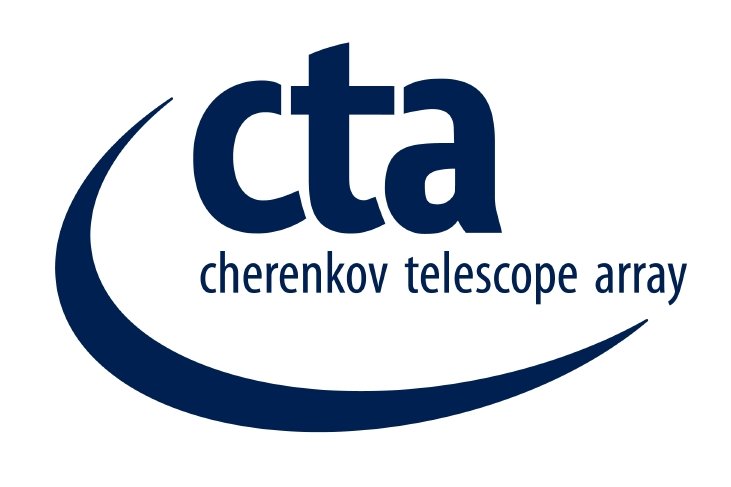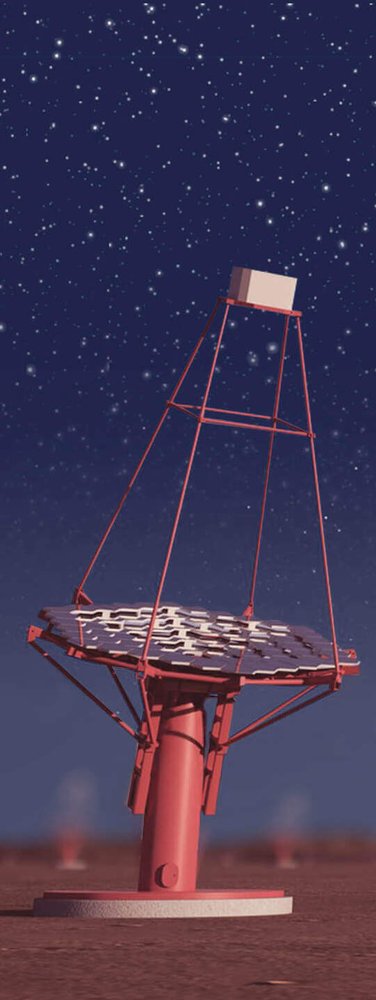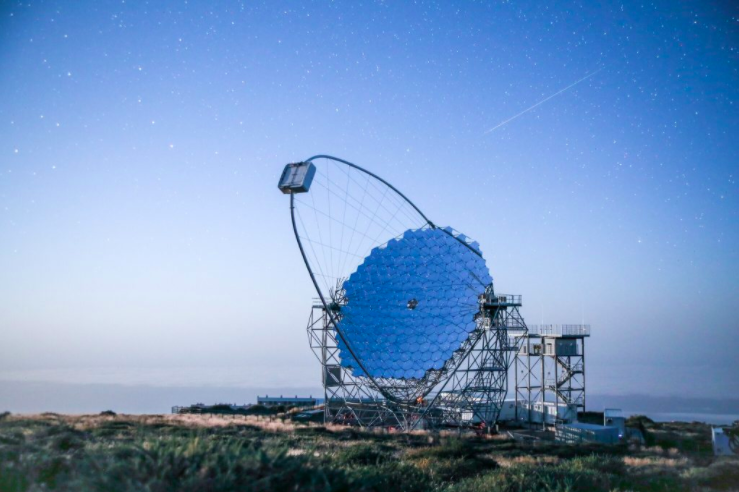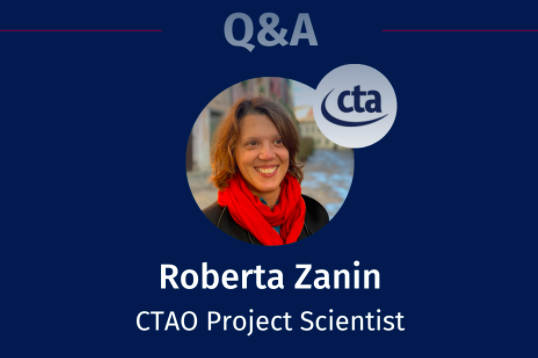The Cherenkov Telescope Array Gamma-observatory

CTA official page

CTA Ukrainian official page

CTA Project and
The Ukrainian Scientific Computer CTA Centre
The Ukrainian Scientific Computer CTA Centre (CTA.UA) was established in 2022 at AO KNU to ensure the participation of Ukrainian scientists in the international infrastructure project of the construction and operation of a new generation gamma-ray observatory: the Cherenkov Telescope Array (CTA).
CTA-Observatory (CTAO), the first open to the worldwide astronomical and astroparticle physics communities ground-based gamma-ray observatory, which will use the most modern advanced equipment for the study of space sources of gamma-rays of high and very high (20 GeV<E<300 TeV) energies with a sensitivity and a collection area up to 10 times higher than the sensitivity and collection area of active gamma-ray telescopes (VERITAS, MSAGIC, H.E.S.S.) and with unprecedented resolution.
The unique capabilities of CTAO will make it possible to conduct a study of physical processes in astrophysical objects with extreme conditions: ultra-high densities of matter and energy, ultra-strong gravitational fields, ultra-relativistic plasma flows, the result of which is the acceleration of cosmic rays and the generation of non-thermal radiation with energies significantly higher than the limits of the Standard Theory. Among the expected manifestations of new physics in CTAO observations there are possible violation of Lorentz invariance, decays/annihilation of dark matter particles, axion-photon oscillations, etc.
Cherenkov Telescope Array Observatory (CTAO): structure and objectives
The structure of the CTA-Observatory provides for two arrays of telescopes in the southern and northern hemispheres, which in the first phase of construction ("Alpha Configuration", future expansion of the arrays is also planned) will include:
- the southern site (CTAO-South) on the Cerro Paranal mountain in the Atacama Desert (Chile, near the European Southern Observatory, ESO) with 14 Medium-Sized Telescopes (MSTs) and 37 Small-Sized Telescopes Telescopes (SSTs);
- the northern site (CTAO-North) on the island of La Palma (Spain) near the Major Atmospheric Gamma-ray Imaging Cherenkov Telescope (MAGIC) with 4 Large-Sized Telescopes (LSTs) and 9 Medium-Sized Telescopes (MSTs).
The Small-Sized Telescope (SST) is designed for recording gamma-rays of the highest energies (5–300 ТеВ). Optical design is a dual-mirror modified Schwarzschild-Couder, the diameter of the primary composite (18 hexagonal segments) reflector is of 4.3 m, the diameter of the secondary mirror is of 1.8 m, and the field of view is of 8.8 deg.
The SST camera consists of 32 silicon photomultipliers, each of which contains 64 (6 mm x 6 mm) pixels and has a field of view of about 9 deg at 2048 pixels.
37 SST-telescopes will be placed at STAO-South.
Medium-Sized Telescope (MST) is designed for recording gamma rays in the key energy interval 150 GeV – 5 TeV. The optical design is modified Davis-Cotton, the diameter of the composite (86 hexagonal-shaped mirrors) reflector is of 11.5 m, and the field of view is of 7.5 (FlashCAM) /7.7 (NectarCAM) deg. MST is equipped with two cameras based on photo multiplier tubes:
- the analog NectarCAM camera contains 265 separate modules, each of which consists of 7 photomultiplier tubes, in total containing 1855 pixels of size 0.17 deg.
- the digital FlashCAM camera consists of photomultiplier tubes arranged in the form of a hexagonal structure and combined in modules of 12 tubes each, in total containing 1764 pixels of size 0.17 deg.
14 MST telescopes will be placed at STAO-South and 9 at STAO-North.
Large-Sized Telescope (LST) is mainly intended for recording gamma-rays in the energy range of 20–150 GeV, although it will retain high sensitivity up to the TeV range. The optical design is an alt-azimuth installation with a 23-meter composite parabolic reflector, a field of view of 4.3 deg. The LST-telescope camera is similar in design to the NectarCAM camera of MST-telescope, it contains 1855 pixels distributed over 265 photomultiplier tube modules. The pixel size is of 0.1 deg, and the full field of view of the camera is of 4.3 degrees.
4 LST telescopes will be placed at STAO-North. The construction of the first of them, LST-1, was completed in October 2018. In March 2023, the LST Collaboration published its first scientific paper “Multiwavelength study of the galactic PeVatron candidate LHAASO J2108+5157”, A&A 673, A75 (2023).
The scientific potential of СTA covers a wide range of astrophysical problems – from the astrophysics of relativistic particles (cosmic rays) to the search for manifestations of dark matter and violation of Lorentz invariance. СTA will explore the extreme Universe from the immediate vicinity of black holes to giant voids (voids) in galaxy distributions. The observational program includes ten key scientific directions (Key Science Project, KSPs): Dark Matter, Galactic Centre, Galactic Plane Survey, LMC Survey, Extragalactic Survey, Transients, Cosmic Ray PeVatrons, Star Forming Systems, Active Galactic Nuclei, Clusters of Galaxies
Countries financing CTAO will establish in autumn 2023 the CTAO European Research Infrastructure Consortium (CTAO ERIC), which will build and operate the gamma-ray observatory.
Participation of Ukrainian scientists in СTA
Ukraine became a member of the CTA Consortium in 2015. Astronomers of the Taras Shevchenko Kyiv National University were the initiators and organizers of Ukraine joining the CTA and form the basis of the Ukrainian scientific group in the CTA. The official document on Ukraine's accession to the CTA was the Memorandum of Understanding signed by the heads of Taras Shevchenko National University of Kyiv, Ivan Franko National University of Lviv, and Pidstrigach Institute for Applied Mechanics and Mathematics of the National Academy of Sciences of Ukraine (CTAC member organizations from Ukraine).
The role of the scientific team of Ukraine in CTAO: the study of extreme astrophysical processes and phenomena at the leading edge of astrophysics and cosmology (the nature of dark matter and dark energy, sources of gravitational waves, cosmic rays and ultra-high-energy neutrinos, physics of active galactic nuclei) based on unique multi-TeV gamma-ray data, received by CTAO. The main area of their responsibility is the development of new models of gamma-ray generation in astrophysical objects and the selection of the optimal strategy for their observation at the CTAO in accordance with the Key Science Projects (10 KSPs, of which Ukraine is involved in 3:
- High-energy physical processes in galaxy clusters and their manifestations in very high-energy gamma-ray emissions (VHEGR);
- VHEGR sources of galactic cosmic rays (CRs) - cosmic PeVatrons;
- VHEGR in multi-channel studies of transient gamma-ray sources, gravitational waves, and cosmogenic neutrinos.

The latest news from CTAO

Q&A WITH PROJECT SCIENTIST, ROBERTA ZANIN
2023-JUNE-15

We got it – the CTAO ERIC will be a reality in August 2023!
2023-JUNE-05

The project participants are authors of publications and co-authors of works of the Consortium.